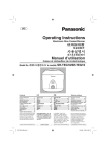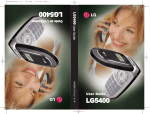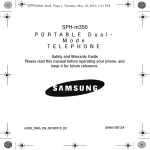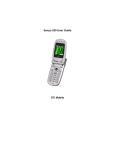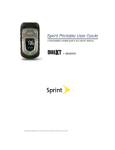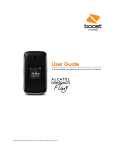Download LG Electronics Sti Telephone User Manual
Transcript
STi Mobile PCS Service PCS Phone VI-5225G Table of Contents How to Use This Guide . . . . . . . . . . . . . . . . . . . . . . . . . . . .i Basics of Your PCS Phone . . . . . . . . . . . . . . . . . . . . . . . . . .1 Your New PCS Phone . . . . . . . . . . . . . . . . . . . . . . . . . . .2 Your Phone’s Features . . . . . . . . . . . . . . . . . . . . . . . . . . . . . . .3 Turning Your Phone On and Off . . . . . . . . . . . . . . . . . . . .5 Turning Your Phone On . . . . . . . . . . . . . . . . . . . . . . . . . . . . . .5 Turning Your Phone Off . . . . . . . . . . . . . . . . . . . . . . . . . . . . . .5 Setting the Language . . . . . . . . . . . . . . . . . . . . . . . . . . .5 Using the Battery and Charger . . . . . . . . . . . . . . . . . . . .6 Installing and Removing the Battery . . . . . . . . . . . . . . . . . . . . .6 Charging the Battery . . . . . . . . . . . . . . . . . . . . . . . . . . . . . . . .6 Making and Answering Calls . . . . . . . . . . . . . . . . . . . . .7 Making Calls . . . . . . . . . . . . . . . . . . . . . . . . . . . . . . . . . . . . . . .7 Answering Calls . . . . . . . . . . . . . . . . . . . . . . . . . . . . . . . . . . . .7 Signal Strength . . . . . . . . . . . . . . . . . . . . . . . . . . . . . . . . . . . . .7 Entering Text . . . . . . . . . . . . . . . . . . . . . . . . . . . . . . . . . .8 Controlling Your Roaming Experience . . . . . . . . . . . . .10 Setting Your Phone’s Roam Mode . . . . . . . . . . . . . . . . . . . . . .10 Call Guard . . . . . . . . . . . . . . . . . . . . . . . . . . . . . . . . . . . . . . .11 Using Your Phone Book . . . . . . . . . . . . . . . . . . . . . . . . .12 Saving Phone Numbers . . . . . . . . . . . . . . . . . . . . . . . . . . . . .12 Finding Phone Numbers . . . . . . . . . . . . . . . . . . . . . . . . . . . .12 Making a Call From Your Phone Book . . . . . . . . . . . . . . . . . . .13 Changing Your Phone’s Settings . . . . . . . . . . . . . . . . .14 Changing the Greeting . . . . . . . . . . . . . . . . . . . . . . . . . . . . . .14 Adjusting the Phone’s Volume Settings . . . . . . . . . . . . . . . . .15 Adjusting the Volume During a Conversation . . . . . . . . . . . .15 Airplane Mode . . . . . . . . . . . . . . . . . . . . . . . . . . . . . . . . . . . .15 TTY Use With PCS Service From Your service provider . . . . .16 Sending and Receiving Messages . . . . . . . . . . . . . . . .17 Setting Up Your Voicemail . . . . . . . . . . . . . . . . . . . . . . . . . . .17 Retrieving Your Voicemail Messages . . . . . . . . . . . . . . . . . . .17 Accessing Your Voicemail From Another Phone . . . . . . . . . .17 Displaying Numeric Pages . . . . . . . . . . . . . . . . . . . . . . . . . . .17 PCS Service Features . . . . . . . . . . . . . . . . . . . . . . . . . .18 Call Waiting . . . . . . . . . . . . . . . . . . . . . . . . . . . . . . . . . . . . . .18 Call Forwarding . . . . . . . . . . . . . . . . . . . . . . . . . . . . . . . . . . .18 Three-Way Calling . . . . . . . . . . . . . . . . . . . . . . . . . . . . . . . . .19 Your Phone’s Special Features . . . . . . . . . . . . . . . . . . .20 Accessories for Your Phone . . . . . . . . . . . . . . . . . . . . . .21 Safety and Terms & Conditions . . . . . . . . . . . . . . . . . . . .23 Performance and Safety . . . . . . . . . . . . . . . . . . . . . . . .24 Getting the Most Out of Your Reception . . . . . . . . . . . . . . . .24 Maintaining Safe Use of and Access to Your Phone . . . . . . . . .25 Caring for the Battery . . . . . . . . . . . . . . . . . . . . . . . . . . . . . . .27 Acknowledging Special Precautions and the FCC Notice . . . .28 Specific Absorption Rates (SAR)for Wireless Phones . . . . . . . . .30 FCC Radiofrequency Emission . . . . . . . . . . . . . . . . . . . . . . . .30 Owner’s Record . . . . . . . . . . . . . . . . . . . . . . . . . . . . . . . . . . .31 User’s Guide Proprietary Notice . . . . . . . . . . . . . . . . . . . . . .31 Index . . . . . . . . . . . . . . . . . . . . . . . . . . . . . . . . . . . . . . . .32 How to Use This Guide Thank you for choosing PCS Service from Your service provider. Your service provider has the most complete, all-digital wireless network in the nation. Depend on it. With PCS Service, we give you what you really want from a wireless service provider – clear calls, easy-to-understand service plans, and selfservicing options for managing your account. All this is designed to make your life easier and worry free. We know you’re eager to start using your phone right away, and the three sections of this guide are designed to help you do just that. 1 Basics of Your PCS Phone. The second section will guide you through the basics of your phone and service with quick, easy-to-follow instructions. 2 Safety and Terms & Conditions. The final section emphasizes important performance and safety guidelines and outlines the terms and conditions of service for your PCS Phone and Service. Basics of Your PCS Phone 1 Your New PCS Phone 16. Earpiece 15. Battery Strength Indicator 1. Signal Strength Indicator 14. Display Screen 2. Softkey Buttons 13. Indicator Light 3. Charger Jack 4. Volume Control 12. OK 5. Talk 11. End (Power) 10. Navigation Key 6. Headset Jack 7. Back (Clear) 9. Microphone 8. Accessory Jack 2 Your Phone’s Features 1. Signal Strength Indicator represents the signal strength by displaying bars. The more bars displayed, the better the signal strength. Basics 2. Softkey Buttons let you select softkey actions or menu items. 3. Charger Jack connects the phone to the battery charger. 4. Volume Control allows you to adjust the ringer volume in standby mode (with the flip open) or adjust the voice volume during a call. The volume key can also be used to scroll up or down to navigate through the different menu options. To mute the ringer during an incoming call, press the volume key up or down. 5. Talk allows you to place or receive a call. In standby mode, press the key once to access the Outgoing call log. 6. Headset Jack allows you to plug in an optional headset for convenient, hands-free conversations. 7. Back (Clear) deletes characters from the display in text entry mode. When in a menu, press to return to the previous menu. This key also allows you to return to the previous screen in a Web session. 8. Accessory Jack allows you to connect optional accessories such as a USB cable. 9. Microphone allows the other caller to hear you clearly when you are speaking to them. 3 10. Navigation Key scrolls through the phone’s menu options and acts as a shortcut key from standby mode. Press Up to access Messaging. Press Down to access Downloads. Press Right to launch a Web Connection. Press Left to view your Calendar or for your own customized shortcut. 11. End (Power) ends a call. Press and hold this key for two seconds to turn your phone On or Off. While in the main menu, it returns the phone to standby mode and cancels your input. When you receive an incoming call, press to enter silent mode and mute the ringer. 12. OK accepts the highlighted choice when navigating through a menu. 13. Indicator Light illuminates when you have an incoming call or new message. Illuminates red while the battery is charging and green when charging is complete. 14. Display Screen displays all the information needed to operate your phone. 15. Battery Strength Indicator represents the amount of remaining battery charge currently available in your phone. When all bars are displayed in the battery icon, the phone’s battery is fully charged. When no bars are displayed, the phone’s battery is completely discharged or empty. 16. Earpiece lets you hear the caller and automated prompts. 4 Turning Your Phone On and Off Turning Your Phone On Basics Press for two seconds. (The phone will display “Searching for Service” until it locates a signal, then it will automatically enter standby mode – the phone’s idle state. At this point, you’re ready to begin making and receiving calls.) Turning Your Phone Off Press for two seconds until you see the “Powering Off” animation. Setting the Language To set your phone’s display language: 1. Press Menu (left softkey ) to access the main menu. 2. Scroll to Settings (Ambiente) and press . 3. Scroll to Setup (Configuración) and press 4. Scroll to Language (Idioma) and press . . 5. Select English (Inglés) or Spanish (Español) and press . 5 Using the Battery and Charger Installing and Removing the Battery To install, insert the battery into the opening on the back of the phone and gently press down until the latch snaps into place. To remove, make sure the power is off. Press the battery release latch up and remove the battery from the phone at a 45-degree angle. Charging the Battery To use the charger provided with your phone: Plug the round end of the AC adapter into the phone’s charger jack and the other end into an electrical outlet. A red indicator light on the phone lets you know the battery is charging. A green indicator light lets you know the battery is at least 90 percent charged. It takes about three hours to fully recharge a completely rundown battery. Important Note: It is vital that you use only approved desktop chargers and AC adapter chargers. Use of unauthorized accessories could damage your phone and invalidate your warranty. 6 Making and Answering Calls Making Calls 1. Make sure your phone is on. 3. Press Basics 2. Enter a phone number. (If you make a mistake while dialing, press to erase one digit at a time or press and hold to erase the entire number.) to place the call. 4. When you’re finished, press or close the flip. Answering Calls 1. Make sure your phone is on. (If your phone is off, incoming calls go to your voicemail.) 2. When your phone rings or vibrates, answer the call by pressing . (Depending on your settings, you may also answer a call by opening the flip or by pressing any key.) 3. To end the call, you can close the flip or press . Signal Strength You can see the strength of your signal by the signal indicator ( ) on your phone’s display screen. GPS satellite signal transmission may be inhibited by poor atmospheric or environmental conditions, indoor operation, or other obstruction. For optimal call performance, please do not obstruct the internal antenna. If you’re inside a building, being near a window may give you better reception. 7 L Entering Text Your PCS Phone makes it easy to enter words, letters, punctuation, and numbers whenever you need to enter text (for example, when entering a Phone Book entry or when using the phone’s messaging features). They are: T9Word: Allows you to enter text using a predictive text entering system that reduces the amount of keys that need to be pressed while entering a word. Abc: Allows you to cycle through the alpha characters associated with the letters on the keypad. 123: Allows you to enter numbers by pressing the corresponding number on the keypad. Symbols: Allows you to enter symbols using the keypad. Smileys: Allows you to enter emoticons with your text message. Canned Messages: Saves time by allowing you to enter pre-programmed messages. To enter text on your PCS Phone: 1. Display a screen that allows for text entry. (For example, saving a new contact name and phone number.) 2. Using the keypad to enter text, press the numbered keys repeatedly until the desired letter appears. (For example, twice, three times, to type “Bill,” press three times, and three times again.) After a character is entered, the cursor automatically advances to the next space after two seconds or when you enter a character on a different key. If you make a mistake while entering text, press to erase one letter at a time, or press and hold to erase the entire entry. 8 Entering Text Using T9 Text Input Basics T9 Text Input (Predictive Text Input) lets you enter text in your PCS Phone by pressing keys just once per letter. When you display certain screens where you can enter text, and there is an Options softkey, you may try using T9 Text Input. To use T9 text input: 1. Enter your text using the keypad. (For example, type “car” by pressing .) The word is not completed until the last letter is pressed. 2. Once a word is complete, press continue entering your text. to create a space and 9 Controlling Your Roaming Experience Your phone is Digital Dual Band, which means you can make and receive calls while on the your service provider and you can also roam on other 1900 MHz and 800 MHz digital networks where we’ve implemented agreements with other carriers. Your phone has several features that let you control your roaming experience. Setting Your Phone’s Roam Mode 1. Press Menu (left softkey ) to access the main menu. 2. Scroll to Settings and press . 3. Scroll to Roaming and press . 4. Select Set Mode and press . 5. To select an option, highlight it and press 10 . Call Guard Basics Call Guard reminds you when you are making or receiving a roaming call and requires you to take additional steps before placing or answering roaming calls. These additional steps are not required when you make or receive calls while on the your service provider, or if your PCS Service Plan includes roaming. To turn Call Guard on: 1. Press Menu (left softkey ) to access the main menu. 2. Scroll to Settings and press . 3. Scroll to Roaming and press . 4. Select Call Guard and press . 5. Highlight On or Off and press . To place roaming calls with Call Guard on: 1. From standby mode, dial 1+area code+seven digit number and press . 2. Select Roam Call and press . To answer incoming calls with Call Guard on: Highlight Answer and press . Feature Availability You can make and receive calls while roaming. You will have access to voicemail while roaming. Other features which are standard on the your service provider, such as Call Waiting, and Web services are unavailable while roaming. 11 Using Your Phone Book Saving Phone Numbers 1. Enter a phone number from standby mode. 2. Press Save (left softkey). 3. Select a label and press . 4. Select New Name for a new contact or Existing to add a number to an existing contact and press . 5. Use the numeric keypad to enter the new contact name and press to save the new entry. – or – Search for an existing contact name and press save the new number. to Finding Phone Numbers 1. Enter one or more digits from standby mode. 2. Select Options (right softkey) and select Search . 3. To display the Phone Book entry that contains the phone number, highlight the entry and press . 4. To dial the number, highlight it and press 12 . Making a Call From Your Phone Book 1. Press Menu (left softkey ) to access the main menu. 2. Scroll to Phone Book and press 3. Select Find Name and press . . Basics Shortcut: From standby mode, select Search (right softkey) to list the entries in your phone book. 4. Highlight the entry you want to call and press 5. Highlight the number you want to call and press . . 13 Changing Your Phone’s Settings You can customize many of your phone’s functions, from the display and sounds to messaging and security, through the Settings menu. Below are just a few examples of how to navigate and use the Settings menu. Changing the Greeting 1. Press Menu (left softkey ) to access the main menu. 2. Scroll to Settings and press . 3. Scroll to Display and press . 4. Select Greeting and press . 5. Use the numeric keypad to type your personalized greeting and press . Note: The default text entry mode for changing your greeting is T9 Text Input. To turn T9 on and off: 1. When in the text entry mode, press T9Word (right softkey). 2. Select an option and press entry options.) 14 . (See page 22 for text Adjusting the Phone’s Volume Settings 1. Press Menu (left softkey ) to access the main menu. 2. Scroll to Settings and press 3. Select Sounds and press . . Basics 4. Scroll to Volume and press . 5. Select Ringer, Earpiece, Key Beep, Power On/Off, or Application. 6. Use your navigation key to select a volume setting. Adjusting the Volume During a Conversation Press the volume keys on the side of your phone during the call. Airplane Mode When your phone is in Airplane Mode, it cannot send or receive any calls or access online information. You may use the phone’s other features, such as Games, Schedule, Notepad, etc. When Airplane Mode is enabled, a message “Phone Off” is displayed on the screen. To access Airplane Mode: 1. Press Menu (left softkey ) to access the main menu. 2. Scroll to Settings and press . 3. Scroll to Airplane Mode and press . (A message will appear explaining that Airplane Mode will prevent outgoing and incoming calls. Press to continue.) 4. Select On or Off and press . 15 TTY Use With PCS Service From Your service provider A TTY (also known as a TDD or Text Telephone) is a telecommunications device that allows people who are deaf or hard of hearing, or who have speech or language disabilities, to communicate by telephone. Your phone is compatible with select TTY devices. Please check with the manufacturer of your TTY device for connectivity information and to ensure that the TTY device supports digital wireless transmission. To turn TTY mode on or off: 1. Press . 2. Read the onscreen message and press 3. Select TTY On and press to continue. to turn TTY mode on. – or – Select TTY Off and press to turn TTY mode off. IMPORTANT Your service provider recommends that TTY users make emergency calls by other means, including NOTICE: Telecommunications Relay Services (TRS), analog cellular, and landline communications. Wireless TTY calls to 911 may be corrupted when received by public safety answering points (PSAPs) rendering some communications unintelligible. 16 Sending and Receiving Messages Setting Up Your Voicemail 1. Press and hold . Retrieving Your Voicemail Messages Press and hold . Follow the system prompts. Accessing Your Voicemail From Another Phone 1. Dial your PCS Phone Number. 2. Press when your voicemail answers. 3. Enter your pass code. Displaying Numeric Pages 1. Press Menu (left softkey ) to access the main menu. 2. Scroll to Messaging and press 3. Select Inbox and press . . 4. Highlight a folder containing a new message and press . (An asterisk before a folder indicates an unread message.) 5. Highlight the message you want to display and press . (To display additional text, press the navigation key down.) 17 Basics 2. Follow the system prompts to create your pass code and record your greeting. PCS Service Features Call Waiting To respond to an incoming call while you’re on a call: Put your first call on hold and answer the second call by pressing . (To switch between calls, press again.) – or – End your first call and answer the incoming call by pressing , followed by . Call Forwarding Call Forwarding lets you forward your calls to another number. You can still make calls from your phone while this is activated. There is a per-call charge for this service. To activate: 1. Press . 2. Enter the area code and phone number to which your calls should be forwarded. 3. Press . (You will see a message and hear a tone confirming the activation of Call Forwarding.) To deactivate: 1. Press . 2. Press . (You will see a message and hear a tone confirming the deactivation.) 18 Three-Way Calling Talking with two different people at the same time is made easy with Three-Way Calling. To place a three-way call: . Basics 1. Enter a number you wish to call and press 2. Once you have established the connection, press Options (right softkey) and select 3 Way Call. (This puts the first call on hold and allows you to dial the second number.) 3. Dial the second number you wish to call and press . 4. When you’re connected to the second party, press once more to begin your three-way call. If one of the people you called hangs up, you and the remaining caller stay connected. If you initiated the call and are the first to hang up, all three callers will be disconnected. Note: When using Three-Way Calling, normal airtime rates will be charged for each of the two calls. 19 Your Phone’s Special Features Calendar The built-in Calendar offers several personal information management features to help you manage your busy lifestyle. Location Your PCS Phone is equipped with a Location feature for use in connection with location-based services that may be available in the future. External Display Your phone’s external LCD display allows you to monitor the phone’s status and to see who’s calling without opening the phone. Alarm Clock Lets you set up to three important times and alerts you when these set times occur. Notepad Allows you to type yourself notes. Calculator Allows you to perform basic mathematical operations. World Clock Displays the time for more than fifty locations around the world. 20 Accessories for Your Phone Standard Battery Provides up to 2.5 hours of continuous talk time or up to 8 days of continuous standby time. Basics Extended Battery Provides up to 4.5 hours of continuous talk time or up to 11.25 days of continuous standby time. Vehicle Power Adapter This charging option enables you to power your phone and charge the battery at the same time. Plugs into any vehicle charging port. Portable Hands-Free Car Kit Increase vehicle safety by being able to drive and talk with both hands on the wheel. Continuous charging allows you the convenience of a charged battery at all times. No complicated wired installations – just plug and use from any vehicle power outlet. Travel Charger This lightweight, compact charger plugs directly into your phone to charge the battery while traveling. It plugs into any standard 110-220V 60 Hz outlet. Leather Case Made with the highest quality leather to provide secure protection for your PCS Phone. Locking swivel clip is included for maximum convenience and ease of use. Holster Sleek design holds your PCS Phone in the most secure fashion. Locking swivel clip is attached for ease of use. 21 22 Safety and Terms & Conditions 23 Performance and Safety Getting the Most Out of Your Reception Keeping Tabs on Signal Strength The quality of each call you make or receive depends on the signal strength in your area. Your phone informs you of the current signal strength by displaying a number of bars next to the signal strength icon. The more bars displayed, the stronger the signal. If you’re inside a building, being near a window may give you better reception. Understanding the Power Save Feature If your phone is unable to find a signal after 15 minutes of searching, a Power Save feature is automatically activated. If your phone is active, it periodically rechecks service availability or you can check it yourself by pressing any key. Anytime the Power Save feature is activated, a message displays on the screen. When a signal is found, your phone returns to standby mode. Understanding How Your Phone Operates Your phone is basically a radio transmitter and receiver. When it's turned on, it receives and transmits radio frequency (RF) signals. When you use your phone, the system handling your call controls the power level. This power can range from 0.006 watts to 0.2 watts in digital mode. Knowing Radio Frequency Safety The design of your phone complies with updated NCRP standards described below. In 1991-92, the Institute of Electrical and Electronics Engineers (IEEE) and the American National Standards Institute (ANSI) joined in updating ANSI's 1982 standard for safety levels with respect to human exposure to RF signals. More than 120 scientists, engineers and physicians from universities, government health agencies and industries developed this updated standard after reviewing the available body of research. In 1993, the Federal Communications Commission (FCC) adopted this updated standard in a regulation. In August 1996, the FCC adopted a hybrid standard consisting of the 24 existing ANSI/IEEE standard and the guidelines published by the National Council of Radiation Protections and Measurements (NCRP). Maintaining Your Phone’s Peak Performance There are several simple guidelines to operating your phone properly and maintaining safe, satisfactory service. Speak directly into the mouthpiece. Avoid exposing your phone and accessories to rain or liquid spills. If your phone does get wet, immediately turn the power off and remove the battery. If it’s inoperable, return it to a Store or call PCS Customer Solutions for service. Tip: For the best care of your phone, only Authorized Personnel should service your phone and accessories. Faulty service may void the warranty. Maintaining Safe Use of and Access to Your Phone Safety/ Terms & Conditions FAILURE TO FOLLOW THE INSTRUCTIONS OUTLINED MAY LEAD TO SERIOUS PERSONAL INJURY AND POSSIBLE PROPERTY DAMAGE. Using Your Phone While Driving Talking on your phone while driving (or operating the phone without a hands-free device) is prohibited in some jurisdictions. Laws vary as to specific restrictions. Remember that safety always comes first. When using your phone in the car: Get to know your phone and its features, such as speed dial and redial. When available, use a hands-free device. Position your phone within easy reach. Let the person you are speaking to know you are driving; if necessary, suspend the call in heavy traffic or hazardous weather conditions. Do not take notes or look up phone numbers while driving. Dial sensibly and assess the traffic; if possible, place calls when stationary or before pulling into traffic. Do not engage in stressful or emotional conversations that may divert your attention from the road. 25 Dial 911 to report serious emergencies. It’s free from your wireless phone. Use your phone to help others in emergencies. Call roadside assistance or a special non-emergency wireless number when necessary. Following Safety Guidelines To operate your phone safely and efficiently, always follow any special regulations in a given area. Turn your phone off in areas where use is forbidden or when it may cause interference or danger. Using Your Phone Near Other Electronic Devices Most modern electronic equipment is shielded from radiofrequency (RF) signals. However, RF signals from wireless phones may affect inadequately shielded electronic equipment. RF signals may affect improperly installed or inadequately shielded electronic operating systems and/or entertainment systems in motor vehicles. Check with the manufacturer or their representative to determine if these systems are adequately shielded from external RF signals. Also check with the manufacturer regarding any equipment that has been added to your vehicle. Consult the manufacturer of any personal medical devices, such as pacemakers and hearing aids, to determine if they are adequately shielded from external RF signals. Note: Always turn off the phone in health care facilities and request permission before using the phone near medical equipment. Turning Off Your Phone Before Flying Turn off your phone before boarding any aircraft. To prevent possible interference with aircraft systems, the U.S. Federal Aviation Administration (FAA) regulations require you to have permission from a crew member to use your phone while the plane is on the ground. To prevent any risk of interference, FCC regulations prohibit using your phone while the plane is in the air. Turning Off Your Phone in Dangerous Areas To avoid interfering with blasting operations, turn your phone off when in a blasting area or in other areas with signs indicating two-way 26 radios should be turned off. Construction crews often use remotecontrol RF devices to set off explosives. Turn your phone off when you're in any area that has a potentially explosive atmosphere. Although it's rare, your phone and accessories could generate sparks. Sparks can cause an explosion or fire, resulting in bodily injury or even death. These areas are often, but not always, clearly marked. They include: Fueling areas such as gas stations. Below deck on boats. Fuel or chemical transfer or storage facilities. Areas where the air contains chemicals or particles such as grain, dust or metal powders. Any other area where you would normally be advised to turn off your vehicle’s engine. Note: Safety/ Terms & Conditions Never transport or store flammable gas, liquid or explosives in the compartment of your vehicle that contains your phone or accessories. Restricting Children’s Access to Your Phone Your phone is not a toy. Do not allow children to play with it as they could hurt themselves and others, damage the phone or make calls that increase your PCS Invoice. Caring for the Battery Protecting Your Battery The guidelines listed below help you get the most out of your battery’s performance. Use only approved batteries and desktop chargers. These chargers are designed to maximize battery life. Using other batteries or chargers voids your warranty and may cause damage. In order to avoid damage, charge the battery only in temperatures that range from 32º F to 113º F (0º C to 45º C). Don’t use the battery charger in direct sunlight or in high humidity areas, such as the bathroom. 27 Never dispose of the battery by incineration. Keep the metal contacts on top of the battery clean. Don’t attempt to disassemble or short-circuit the battery. The battery may need recharging if it has not been used for a long period of time. It’s best to replace the battery when it no longer provides acceptable performance. It can be recharged hundreds of times before it needs replacing. Don’t store the battery in high temperature areas for long periods of time. It’s best to follow these storage rules: Less than one month: 4º F to 140º F (-20º C to 60º C) More than one month: 4º F to 113º F (-20º C to 45º C) Disposal of Lithium Ion (LiIon) Batteries For safe disposal options of your LiIon batteries, contact your nearest authorized service center. Special Note: Be sure to dispose of your battery properly. In some areas, the disposal of batteries in household or business trash may be prohibited. Note: For safety, do not handle a damaged or leaking LiIon battery. Acknowledging Special Precautions and the FCC Notice FCC Notice This phone may cause TV or radio interference if used in close proximity to receiving equipment. The FCC can require you to stop using the phone if such interference cannot be eliminated. Vehicles using liquefied petroleum gas (propane or butane) must comply with the National Fire Protection Standard (NFPA-58). For a copy of this standard, contact the National Fire Protections Association, One Batterymarch Park, Quincy, MA 02269, Attn.: Publication Sales Division. 28 Cautions Any changes or modifications to your phone not expressly approved in this document could void your warranty for this equipment and void your authority to operate this equipment. Only use approved batteries, antennas and chargers. The use of any unauthorized accessories may be dangerous and void the phone warranty if said cause damage or a defect to the phone. Although your phone is quite sturdy, it is a complex piece of equipment and can be broken. Avoid dropping, hitting, bending or sitting on it. To maintain compliance with FCC RF exposure guidelines, if you wear a handset on your body, use supplied or approved carrying case, holster or other body-worn accessory. If you do not use a body-worn accessory, ensure the antenna is at least 7/16 inch (1.5 centimeters) from your body when transmitting. Use of non- approved accessories may violate FCC RF exposure guidelines. Safety/ Terms & Conditions Body-Worn Operation For more information about RF exposure, visit the FCC Website at www.fcc.gov. 29 Specific Absorption Rates (SAR) for Wireless Phones The SAR is a value that corresponds to the relative amount of RF energy absorbed in the head of a user of a wireless handset. The SAR value of a phone is the result of an extensive testing, measuring and calculation process. It does not represent how much RF the phone emits. All phone models are tested at their highest value in strict laboratory settings. But when in operation, the SAR of a phone can be substantially less than the level reported to the FCC. This is because of a variety of factors including its proximity to a base station antenna, phone design and other factors. What is important to remember is that each phone meets strict federal guidelines. Variations in SARs do not represent a variation in safety. All phones must meet the federal standard, which incorporates a substantial margin of safety. As stated above, variations in SAR values between different model phones do not mean variations in safety. SAR values at or below the federal standard of 1.6 W/kg are considered safe for use by the public. The highest reported SAR values of the VI-5225G are: PCS mode (Part 24): Head: 0.605 W/kg; Body-worn: 0.604 W/kg FCC Radiofrequency Emission This phone meets the FCC Radiofrequency Emission Guidelines. FCC ID number: BEJLX5400. More information on the phone's SAR values and testing can be found from the following FCC Website: http://www.fcc.gov/oet/fccid. 30 Owner’s Record The model number, regulatory number and serial number are located on a nameplate inside the battery compartment. Record the serial number in the space provided below. This will be helpful if you need to contact us about your phone in the future. Model: PCS Phone VI-5225G Serial No.: CDMA Technology is licensed by QUALCOMM Incorporated under one or more of the following patents: 4,901,307 5,109,390 5,267,262 5,416,797 5,506,865 5,544,196 5,657,420 5,101,501 Safety/ Terms & Conditions User’s Guide Proprietary Notice 5,267,261 5,414,796 5,504,773 5,535,239 5,600,754 5,778,338 5,228,054 5,337,338 5,710,784 5,056,109 5,568,483 5,659,569 5,490,165 5,511,073 T9 Text Input is licensed by Tegic Communications and is covered by U.S. Pat. 5,818,437, U.S. Pat. 5,953,541, U.S. Pat. 6,011,554 and other patents pending. User’s Guide template version 4A (02-04) 31 Index M Making Calls 7 A Airplane Mode 15 Alarm Clock 20 Answering Calls 7 B Battery 6 C Calculator 20 Calendar 20 Call Forwarding 18 Call Guard 11 Call Waiting 18 D Display Language 5 Display Greeting 14 E Entering Text 8-9 ABC Mode 8 Canned Messages 8 Emoticons 8 Numbers 8 Symbols 8 T9 Text Input 9 L Location 20 32 P Phone (Illus.) 2 Phone Book 12-13 Finding Phone Numbers 12 Making a Call From Your Phone Book 13 Saving Phone Numbers 12 Phone Settings 14-16 Airplane Mode 15 Display Settings 14 TTY Use 16 Volume Settings 15 R Roaming 10 Setting Roam Mode 10 S Saving Phone Numbers 12 T T9 Text Input 9 Text Greeting 14 TTY Use 16 Turning Your Phone On and Off 5 Three-Way Calling 19 V Voicemail 17 Retrieving 17 Setting Up 17 Volume 15 Index 33











































